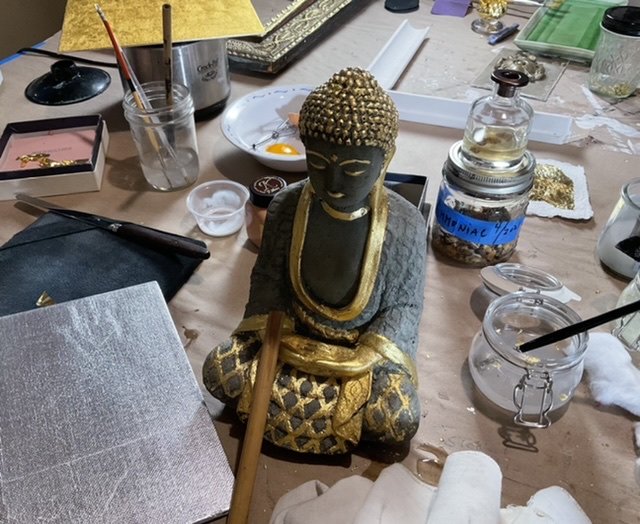Water And Oil-Based Sizes
The process of gilding wood involves the use of either of two methods: Traditional Water Gilding and Mordant gilding, often with the use of Oil Size. Sometimes the two methods are combined on the same object for different effects. However, if we oil gild with an oil size, what are we doing then when we gild with a water based acrylic emulsion? Good question!
The modern day acrylic emulsions for use in gilding - the Dux brand is one that comes to mind - are water based but are certainly not to be confused with traditional water gilding, a centuries old, complex method of gilding that allows burnishing of the gold or silver leaf with an agate stone. Since acrylic emulsion sizes are not oil based they cannot be categorized as oil gilding. So what are they?
Oil gilding uses a linseed oil-based varnish-like medium which we call oil size. The term size implies an adhesive. Oil sizes are referred to according to their drying times: slow size and quick size. Within these two parameters there are actually a number of different drying times available - usually 1 hour, 3 hour, 12 hour or more. The hour designation refers to the approximate length of time it takes for the size to reach the appropriate tack window needed to begin gilding. This window of time, where the size is just tacky enough that when you draw your bare knuckle across the oiled surface you hear a squeak, eventually closes to the point where the oil size will no longer adhere the leaf to the surface.
Oil Size: Quick And Slow
A slow dry oil size, a term that is reserved for the 12 hour or longer versions, have the longest open windows of any of the oil sizes and the greatest leveling properties. It takes a fairly long time to reach the window when one can begin gilding - approximately 12 to 17 hours for the 12 Hour - and remains open for quite some time after that, perhaps 36 hours or more depending upon weather conditions.
A quick oil size comes to tack quickly but will leave its window quickly as well. It usually stays tacky enough, however, to do a small job nicely. I sometimes mix a slow and a fast dry Dux brand oil size at a 80:20 ratio (Slow:Quick) to gain greater control over the drying time.
So with all this talk about oil size, where are we with acrylic emulsion? After applying the emulsion size to the surface, it behaves like oil size in that it needs to have time to set up and a window that eventually (emphasis on eventually!) closes. But it's not oil gilding. It's water-based but it's not water gilding.
The explanation is actually quite easy. This is the umbrella term initially mentioned that covers both oil gilding and acrylic emulsion: Mordant Gilding. A mordant is an adhesive medium that is used as a binder for gold leaf as well as silver and other metal leafs. In fact, oil size and acrylic emulsions are only two mordants; historically, a variety of binders, or mordants, have been used in gilding including garlic, glair (egg white), gum ammoniac, fig juice, and gum tragacanth.
Acrylic Emulsion: Pros And Cons
The new acrylic emulsions have some positives and negatives. They are water-based, therefore clean up easily with soap and water allowing you to avoid the somewhat messy mineral spirits and gummy residue associated with oil size. However, oil size, especially the slow dry, is nicely self-leveling, whereby an acrylic emulsion essentially lays the same way that it's brushed onto the surface, so you need to finesse it carefully by feathering it out. But the acrylics can be gilded after about fifteen minutes or as long as thirty-six hours. I tested a piece recently and gilded a board after the emulsion size had dried for thirty-six hours and it gilded very well with great retention. I actually had an instance where I gilded an artist’s board where the window stayed open for a week and gilded fine, which may or may not be a plus unless you're gilding some very large walls! But the end result still can be quite nice although I do enjoy the sense of harder curing of the oil size but I find there is room for both depending on the project.
The one thing that can be bothersome about the acrylic emulsion is the brush marks left in the size since it isn't very self-leveling. But it's certainly worth working with if you have a good touch and are good with a brush, and if working on a canvas with its inherent texture these brush marks can go into the background. Be mindful though on the type of project you use it on because it never seems to completely dry hard if you’re used to working with oil size. If it's not a piece that's going to be handled and is given a light shellac coat, then by all means try it and see if you can use it in your own work. The flexibility of acrylic emulsion on such surfaces as canvas and leather is amazing which is likely related to its tendency retain a slight tackiness. So if flexibility is a requirement for your project it could well be worth the tradeoff! ~
For those interested in studying gilding Charles Douglas Gilding Studio offers both In-Person and Online Classes including studies in Glass Gilding, Verre Églomisé, Mordant Gilding, and Traditional Water Gilding. Visit the website page Gilding Class Information for more detail or go to the Book A Gilding Class page for an up-to-date class schedule and Registration.


